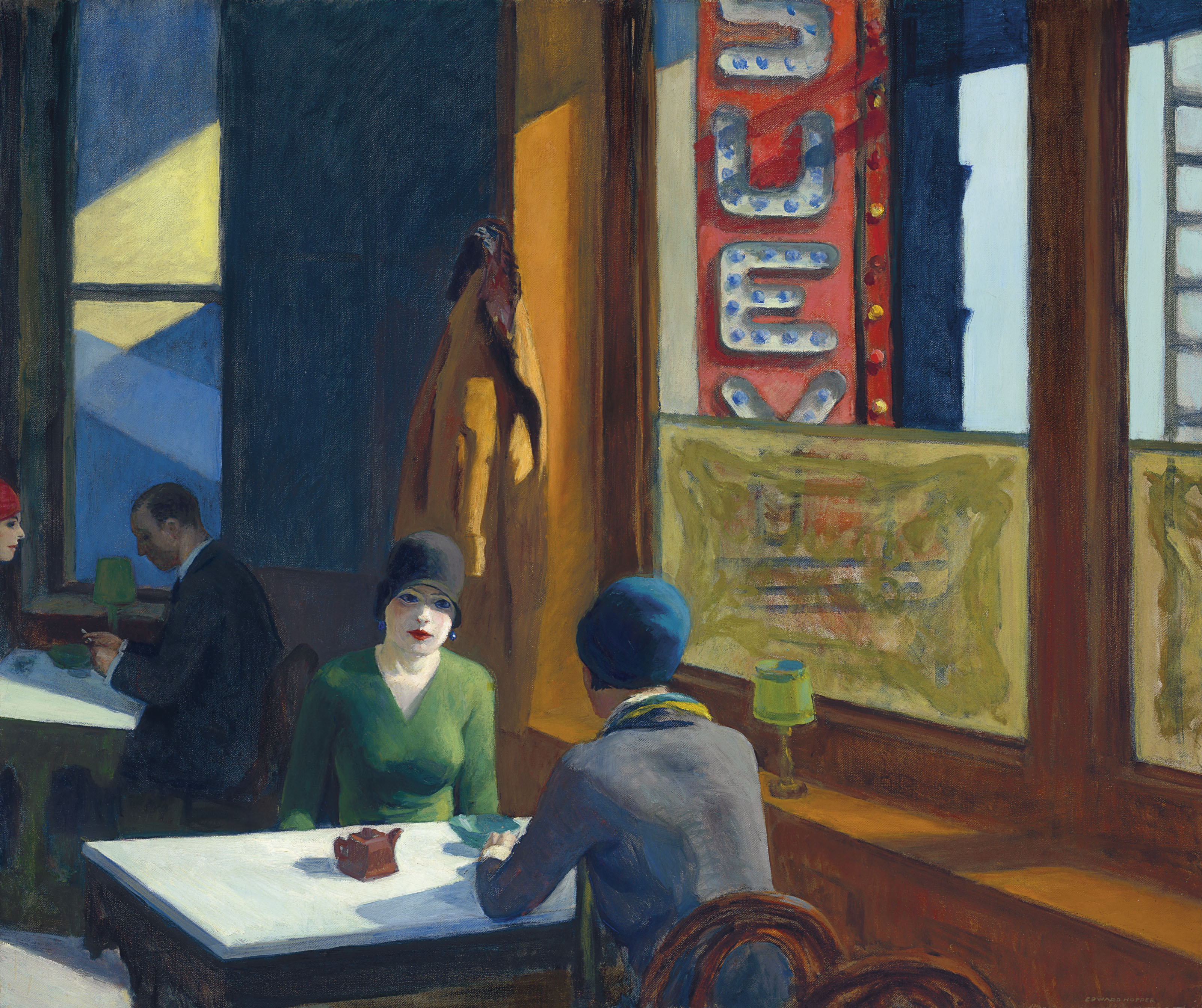Image: Edward Hopper (1882-1967), Chop Suey, 1929. Oil on canvas, 32 x 38 in (81.3 x 96.5 cm). Estimate: $70-100 million. Offered on 13 November in An American Place: The Barney A. Ebsworth Collection Evening Sale at Christie’s in New York
As art historian Robert Hobbs has written, American painter Edward Hopper (1882-1967) was concerned above all ‘with general human values’, using art ‘as a way to frame the forces at work in the modern world’. Chop Suet (1929), the most iconic painting by Hopper left in private hands, epitomises the psychological complexity for which his work is celebrated, freezing in place an everyday scene from an America that was changing rapidly.
In his early years Hopper studied painting at the New York School of Art under Robert Henri, the leader of the Aschan School, which emphasised a gritty realism. Although his style would transform over time, Hopper never abandoned Henri’s central teaching: to paint the city and street life he knew best. While some of his contemporaries focused on the flamboyant flapper set, Hopper trained his eye on the quieter, quotidian dramas unfolding in unpretentious places such as Chinese restaurants, automats and diners.
Derived from the Cantonese phrase tsap sui, meaning ‘odds and ends’, chop suey restaurants had by the mid-1920s evolved into popular luncheonettes where the new working class could grab a bite to eat. Hopper’s oil paintings were often a result of a combination of his past experiences, and it is thought that Chop Suey was partially inspired by two restaurants the artist visited in the 1920s.
The Far East Tea Garden, located at 8 Columbus Circle on New York City’s Upper West Side, was a second-floor spot that Hopper and his wife Josephine frequented in the early years of their marriage. The Empire Chop Suey in Portland, Maine, where the Hoppers spent the summer of 1927, boasted a similarly striking sign — 24ft high and weighing 600 pounds — to the one that features so prominently in the painting. Neither establishment still exists.
 Edward Hopper (1882-1967), Chop Suey, 1929. Oil on canvas, 32 x 38 in (81.3 x 96.5 cm). Estimate: $70-100 million. Offered on 13 November in An American Place: The Barney A. Ebsworth Collection Evening Sale at Christie’s in New York
Edward Hopper (1882-1967), Chop Suey, 1929. Oil on canvas, 32 x 38 in (81.3 x 96.5 cm). Estimate: $70-100 million. Offered on 13 November in An American Place: The Barney A. Ebsworth Collection Evening Sale at Christie’s in New York
In Chop Suey, two women sit at a table, with another couple partially visible in the background. The bright white tables are conspicuously empty, with only the Asian teapot on the near table suggesting any Chinese influence. Art historian Judith A. Barter has explained that this is characteristic of Hopper’s style: ‘There is never anything to eat on Hopper’s tables. Famously uninterested in food, Hopper and his wife often made dinner from canned ingredients. What he found important were the spaces where eating and drinking took place.’
Hopper’s restaurant paintings reflect the shifting role and view of American women in the late 1920s. Chop suey joints were spaces where the new female workforce was welcome — indeed, the woman facing the viewer is the painting’s focal point. But rather than basking in the light streaming in from the restaurant window, she appears pensive, avoiding eye contact with either the viewer or her companion.
Posed for by Josephine Hopper — as were all three female figures in the scene — she seems removed from the woman sitting just across from her. This sense of distance is heightened by Hopper’s practice of using light almost as a theatre spotlight, contributing an unsettling sense of solitude.
‘Hopper’s restaurant pictures... understand something essential about the character of the modern city in which he painted’ — Patricia Junker, curator, Seattle Art Museum
‘In New York’s restaurants, women, especially young ones, were on public display as never before,’ explains Patti Junker, curator of American art at the Seattle Art Museum. ‘Hopper’s restaurant pictures all focus on these young working-class women, and thus they understand something essential about the character of the modern city in which he painted. They reveal, too, the social and sexual tensions that came with new public roles for men and women. Hopper’s New York café women of the 1920s are among his most psychologically and sexually charged character studies.’
Hopper plays as much with colour and light as he does with mood. In the background, swathes of cool blues are bisected by bands of strong white light, casting a near-abstract pattern on the walls. The warm hues in the foreground, meanwhile, draws attention to the striking red, white and blue of the gleaming sign outside.
It was perhaps this play of light and form that so attracted Abstract Expressionist Mark Rothko, who was inspired by Chop Suey in his early career. In incorporating the bold signage of the city streets, Chop Suey also foreshadows Pop Art, with Hopper’s exploration of the commoditisation of dining in the 1920s anticipating the themes of Pop Art a half-century later.
Chop Suey will be offered on 13 November in An American Place: The Barney A. Ebsworth Collection Evening Sale at Christie’s in New York, having been toured to Paris, New York, Hong Kong and Los Angeles (23-27 October).
‘Christie’s is honoured to have been entrusted with this great collection, which brings Hopper’s great masterpiece back to Paris five years after his retrospective,’ said Marc Porter, Chairman of Christie’s Americas, at the start of the tour. ‘With Hopper’s Nighthawks travelling to the Shanghai Museum this fall, at the same time that Chop Suey tours to Christie’s Hong Kong, the artist’s two greatest masterpieces will be on view to the public in Asia, introducing new generations of collectors to the brilliance of this great American master.’

